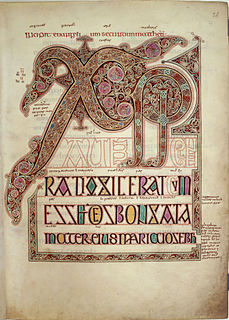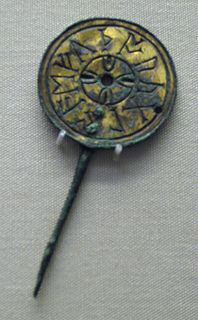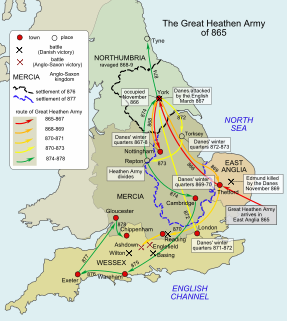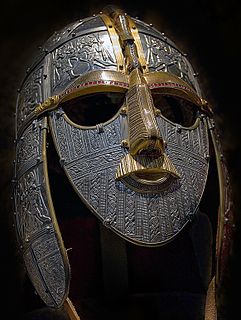Related Research Articles

Amethyst is a violet variety of quartz. The name comes from the Koine Greek ἀμέθυστος amethystos from ἀ- a-, "not" and μεθύσκω methysko / μεθύω methyo, "intoxicate", a reference to the belief that the stone protected its owner from drunkenness. The ancient Greeks wore amethyst and carved drinking vessels from it in the belief that it would prevent intoxication.

The Kingdom of the East Saxons, today referred to as the Kingdom of Essex, was one of the seven traditional kingdoms of the Anglo-Saxon Heptarchy. It was founded in the 6th century and covered the territory later occupied by the counties of Essex, Hertfordshire, Middlesex and Kent. The last king of Essex was Sigered of Essex and in 825, he ceded the kingdom to Ecgberht, King of Wessex.
Old English, or Anglo-Saxon, is the earliest historical form of the English language, spoken in England and southern and eastern Scotland in the early Middle Ages. It was brought to Great Britain by Anglo-Saxon settlers in the mid-5th century, and the first Old English literary works date from the mid-7th century. After the Norman conquest of 1066, English was replaced, for a time, as the language of the upper classes by Anglo-Norman, a relative of French. This is regarded as marking the end of the Old English era, as during this period the English language was heavily influenced by Anglo-Norman, developing into a phase known now as Middle English.

The Anglo-Saxons were a cultural group who inhabited England from the 5th century. They comprised people from Germanic tribes who migrated to the island from continental Europe, their descendants, and indigenous British groups who adopted many aspects of Anglo-Saxon culture and language. The Anglo-Saxons established the Kingdom of England, and the modern English language owes almost half of its words – including the most common words of everyday speech – to their language.

A lapidary is an artist or artisan who forms stone, minerals, or gemstones into decorative items such as cabochons, engraved gems, and faceted designs. A lapidarist uses the lapidary techniques of cutting, grinding, and polishing. Hardstone carving requires specialized carving techniques.

Wulfhere or Wulfar was King of Mercia from 658 until 675 AD. He was the first Christian king of all of Mercia, though it is not known when or how he converted from Anglo-Saxon paganism. His accession marked the end of Oswiu of Northumbria's overlordship of southern England, and Wulfhere extended his influence over much of that region. His campaigns against the West Saxons led to Mercian control of much of the Thames valley. He conquered the Isle of Wight and the Meon valley and gave them to King Æthelwealh of the South Saxons. He also had influence in Surrey, Essex, and Kent. He married Eormenhild, the daughter of King Eorcenberht of Kent.

Anglo-Saxon architecture was a period in the history of architecture in England, and parts of Wales, from the mid-5th century until the Norman Conquest of 1066. Anglo-Saxon secular buildings in Britain were generally simple, constructed mainly using timber with thatch for roofing. No universally accepted example survives above ground.

Anglo-Saxon runes are runes used by the early Anglo-Saxons as an alphabet in their writing. The characters are known collectively as the futhorc (fuþorc), from the Old English sound values of the first six runes. The futhorc was a development from the 24-character Elder Futhark. Since the futhorc runes are thought to have first been used in Frisia before the Anglo-Saxon settlement of Britain, they have also been called Anglo-Frisian runes. They were likely used from the 5th century onward, recording Old English and Old Frisian.

Ecgbert was an 8th-century cleric who established the archdiocese of York in 735. In 737, Ecgbert's brother became king of Northumbria and the two siblings worked together on ecclesiastical issues. Ecgbert was a correspondent of Bede and Boniface and the author of a legal code for his clergy. Other works have been ascribed to him, although the attribution is doubted by modern scholars.

Anglo-Saxon art covers art produced within the Anglo-Saxon period of English history, beginning with the Migration period style that the Anglo-Saxons brought with them from the continent in the 5th century, and ending in 1066 with the Norman Conquest of a large Anglo-Saxon nation-state whose sophisticated art was influential in much of northern Europe. The two periods of outstanding achievement were the 7th and 8th centuries, with the metalwork and jewellery from Sutton Hoo and a series of magnificent illuminated manuscripts, and the final period after about 950, when there was a revival of English culture after the end of the Viking invasions. By the time of the Conquest the move to the Romanesque style is nearly complete. The important artistic centres, in so far as these can be established, were concentrated in the extremities of England, in Northumbria, especially in the early period, and Wessex and Kent near the south coast.
Anglo-Saxon England was early medieval England, existing from the 5th to the 11th centuries from the end of Roman Britain until the Norman conquest in 1066. It consisted of various Anglo-Saxon kingdoms until 927 when it was united as the Kingdom of England by King Æthelstan. It became part of the short-lived North Sea Empire of Cnut the Great, a personal union between England, Denmark and Norway in the 11th century.

The Coronation Stone is an ancient sarsen stone block which is believed to have been the site of the coronation of seven Anglo-Saxon kings. It is presently located next to the Guildhall in Kingston upon Thames, England. Kingston is now a town in the Royal Borough of Kingston Upon Thames in Greater London, but remains the seat of the administration of the county of Surrey.

The Great Heathen Army, also known as Great Danish Army or the Viking Great Army, was a coalition of Scandinavian warriors, mainly Danish but including warriors from Norway and Sweden, who invaded England in 865 AD. Since the late 8th century, the Vikings had engaged in raids on centres of wealth such as monasteries. The Great Heathen Army was much larger and aimed to occupy and conquer the four English kingdoms of East Anglia, Northumbria, Mercia and Wessex.

The Kingdom of the East Angles, today known as the Kingdom of East Anglia, was a small independent kingdom of the Angles comprising what are now the English counties of Norfolk and Suffolk and perhaps the eastern part of the Fens. The kingdom formed in the 6th century in the wake of the Anglo-Saxon settlement of Britain. It was ruled by the Wuffingas dynasty in the 7th and 8th centuries, but fell to Mercia in 794, and was conquered by the Danes in 869, to form part of the Danelaw. It was conquered by Edward the Elder and incorporated into the Kingdom of England in 918.

St Peter's Church is in the village of Heysham, Lancashire, England. It is recorded in the National Heritage List for England as a designated Grade I listed building. It is an active Anglican parish church in the deanery of Lancaster, the archdeaconry of Lancaster and the diocese of Blackburn.
British Latin or British Vulgar Latin was the Vulgar Latin spoken in Great Britain in the Roman and sub-Roman periods. While Britain formed part of the Roman Empire, Latin became the principal language of the elite, especially in the more Romanised south and east of the island. However, in the less Romanised north and west it never substantially replaced the Brittonic language of the indigenous Britons. In recent years, scholars have debated the extent to which British Latin was distinguishable from its continental counterparts, which developed into the Romance languages.

The Anglo-Saxon settlement of Britain is the process which changed the language and culture of most of what became England from Romano-British to Germanic. The Germanic-speakers in Britain, themselves of diverse origins, eventually developed a common cultural identity as Anglo-Saxons. This process occurred from the mid-fifth to early seventh centuries, following the end of Roman rule in Britain around the year 410. The settlement was followed by the establishment of Anglo-Saxon kingdoms in the south and east of Britain, later followed by the rest of modern England.

The Old English Hexateuch is the collaborative project of the late Anglo-Saxon period that translated the six books of the Hexateuch into Old English, presumably under the editorship of Ælfric of Eynsham. It is the first English vernacular translation of the first six books of the Old Testament, i.e. the five books of the Torah and Joshua. It was probably made for use by lay people.
Peter Dendle is a professor of English at Penn State Mont Alto, teaching classes on folklore, 20th and 21st century representations of the Middle Ages, Old and Middle English, and the monstrous. Dendle has written books and articles on a number of topics, including cryptozoology, philology, the demonic in literature, zombie movies, and Medieval plants and medicine. His work on zombies was featured by NPR.

A lapidary is a text, often a whole book, giving "information about the properties and virtues of precious and semi-precious stones", that is to say a work on gemology. Lapidaries were very popular in the Middle Ages, when belief in the inherent power of gems for various purposes was widely held, and among the wealthy collecting jewels was often an obsession, as well as a popular way to store and transport capital.
References
- Peter Kitson, 'Lapidary traditions in Anglo-Saxon England: part I, the background; the Old English Lapidary' in: Anglo-Saxon England, vol. 7, eds. Martin Biddle, Julian Brown, Peter Clemoes, Cambridge University Press, 2007, ISBN 978-0-521-03864-5, 9-60.
- Joan Evans and Mary Sidney Serjeantsen (eds.), English Mediaeval Lapidaries, Early English Text Society Original Series 190, 1933 (reprinted 1999), ISBN 0-85991-925-0.
- Robert Max Garrett, Precious stones in old English literature (1909)